[English] 日本語
 Yorodumi
Yorodumi- PDB-5zg3: Crystal structure of the GluA2o LBD in complex with glutamate and... -
+ Open data
Open data
- Basic information
Basic information
| Entry | Database: PDB / ID: 5zg3 | ||||||
|---|---|---|---|---|---|---|---|
| Title | Crystal structure of the GluA2o LBD in complex with glutamate and TAK-137 | ||||||
 Components Components | Glutamate receptor 2 | ||||||
 Keywords Keywords | TRANSPORT PROTEIN / AMPA RECEPTOR LIGAND-BINDING DOMAIN / ALLOSTERIC MODULATION COMPLEX / MEMBRANE PROTEIN | ||||||
| Function / homology |  Function and homology information Function and homology informationActivation of AMPA receptors / Trafficking of GluR2-containing AMPA receptors / postsynaptic endocytic zone / ligand-gated monoatomic cation channel activity / AMPA glutamate receptor activity / Unblocking of NMDA receptors, glutamate binding and activation / AMPA glutamate receptor complex / Long-term potentiation / asymmetric synapse / excitatory synapse ...Activation of AMPA receptors / Trafficking of GluR2-containing AMPA receptors / postsynaptic endocytic zone / ligand-gated monoatomic cation channel activity / AMPA glutamate receptor activity / Unblocking of NMDA receptors, glutamate binding and activation / AMPA glutamate receptor complex / Long-term potentiation / asymmetric synapse / excitatory synapse / glutamate-gated receptor activity / MECP2 regulates neuronal receptors and channels / ionotropic glutamate receptor signaling pathway / transmitter-gated monoatomic ion channel activity involved in regulation of postsynaptic membrane potential / synaptic transmission, glutamatergic / postsynaptic density membrane / modulation of chemical synaptic transmission / endocytic vesicle membrane / amyloid-beta binding / chemical synaptic transmission / dendritic spine / postsynapse / postsynaptic density / external side of plasma membrane / neuronal cell body / dendrite / signal transduction / plasma membrane Similarity search - Function | ||||||
| Biological species |  Homo sapiens (human) Homo sapiens (human) | ||||||
| Method |  X-RAY DIFFRACTION / X-RAY DIFFRACTION /  SYNCHROTRON / SYNCHROTRON /  MOLECULAR REPLACEMENT / Resolution: 1.65 Å MOLECULAR REPLACEMENT / Resolution: 1.65 Å | ||||||
 Authors Authors | Sogabe, S. / Igaki, S. / Hirokawa, A. / Zama, Y. / Lane, W. / Snell, G. | ||||||
 Citation Citation |  Journal: Neuropsychopharmacology / Year: 2019 Journal: Neuropsychopharmacology / Year: 2019Title: TAK-137, an AMPA-R potentiator with little agonistic effect, has a wide therapeutic window. Authors: Kunugi, A. / Tanaka, M. / Suzuki, A. / Tajima, Y. / Suzuki, N. / Suzuki, M. / Nakamura, S. / Kuno, H. / Yokota, A. / Sogabe, S. / Kosugi, Y. / Awasaki, Y. / Kaku, T. / Kimura, H. | ||||||
| History |
|
- Structure visualization
Structure visualization
| Structure viewer | Molecule:  Molmil Molmil Jmol/JSmol Jmol/JSmol |
|---|
- Downloads & links
Downloads & links
- Download
Download
| PDBx/mmCIF format |  5zg3.cif.gz 5zg3.cif.gz | 635.9 KB | Display |  PDBx/mmCIF format PDBx/mmCIF format |
|---|---|---|---|---|
| PDB format |  pdb5zg3.ent.gz pdb5zg3.ent.gz | 524.2 KB | Display |  PDB format PDB format |
| PDBx/mmJSON format |  5zg3.json.gz 5zg3.json.gz | Tree view |  PDBx/mmJSON format PDBx/mmJSON format | |
| Others |  Other downloads Other downloads |
-Validation report
| Summary document |  5zg3_validation.pdf.gz 5zg3_validation.pdf.gz | 1.6 MB | Display |  wwPDB validaton report wwPDB validaton report |
|---|---|---|---|---|
| Full document |  5zg3_full_validation.pdf.gz 5zg3_full_validation.pdf.gz | 1.6 MB | Display | |
| Data in XML |  5zg3_validation.xml.gz 5zg3_validation.xml.gz | 67.4 KB | Display | |
| Data in CIF |  5zg3_validation.cif.gz 5zg3_validation.cif.gz | 94.5 KB | Display | |
| Arichive directory |  https://data.pdbj.org/pub/pdb/validation_reports/zg/5zg3 https://data.pdbj.org/pub/pdb/validation_reports/zg/5zg3 ftp://data.pdbj.org/pub/pdb/validation_reports/zg/5zg3 ftp://data.pdbj.org/pub/pdb/validation_reports/zg/5zg3 | HTTPS FTP |
-Related structure data
| Related structure data |  5zg0C  5zg1C  5zg2C  1ftjS S: Starting model for refinement C: citing same article ( |
|---|---|
| Similar structure data |
- Links
Links
- Assembly
Assembly
| Deposited unit | 
| ||||||||
|---|---|---|---|---|---|---|---|---|---|
| 1 | 
| ||||||||
| 2 | 
| ||||||||
| 3 | 
| ||||||||
| Unit cell |
|
- Components
Components
-Protein , 1 types, 6 molecules ABCDEF
| #1: Protein | Mass: 29337.830 Da / Num. of mol.: 6 / Fragment: UNP residues 413-527,UNP residues 653-796 Source method: isolated from a genetically manipulated source Source: (gene. exp.)  Homo sapiens (human) / Gene: GLUR2 / Production host: Homo sapiens (human) / Gene: GLUR2 / Production host:  |
|---|
-Non-polymers , 5 types, 1094 molecules 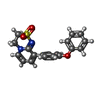
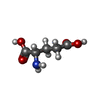

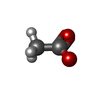





| #2: Chemical | | #3: Chemical | ChemComp-GLU / #4: Chemical | ChemComp-ZN / #5: Chemical | ChemComp-ACT / #6: Water | ChemComp-HOH / | |
|---|
-Details
| Has protein modification | Y |
|---|
-Experimental details
-Experiment
| Experiment | Method:  X-RAY DIFFRACTION / Number of used crystals: 1 X-RAY DIFFRACTION / Number of used crystals: 1 |
|---|
- Sample preparation
Sample preparation
| Crystal | Density Matthews: 2.49 Å3/Da / Density % sol: 50.65 % |
|---|---|
| Crystal grow | Temperature: 277 K / Method: vapor diffusion, sitting drop / pH: 4.9 Details: 15% PEG 3350, 0.1M SODIUM ACETATE, 0.1M ZINC ACETATE |
-Data collection
| Diffraction | Mean temperature: 100 K |
|---|---|
| Diffraction source | Source:  SYNCHROTRON / Site: SYNCHROTRON / Site:  ALS ALS  / Beamline: 5.0.3 / Wavelength: 0.976486 Å / Beamline: 5.0.3 / Wavelength: 0.976486 Å |
| Detector | Type: ADSC QUANTUM 315r / Detector: CCD / Date: Nov 12, 2010 |
| Radiation | Protocol: SINGLE WAVELENGTH / Monochromatic (M) / Laue (L): M / Scattering type: x-ray |
| Radiation wavelength | Wavelength: 0.976486 Å / Relative weight: 1 |
| Reflection | Resolution: 1.65→50 Å / Num. obs: 205163 / % possible obs: 99.6 % / Redundancy: 3.8 % / Rsym value: 0.062 / Net I/σ(I): 19 |
| Reflection shell | Resolution: 1.65→1.68 Å / Redundancy: 3.6 % / Mean I/σ(I) obs: 1.5 / Num. unique obs: 10200 / Rsym value: 0.841 / % possible all: 99.1 |
- Processing
Processing
| Software |
| ||||||||||||||||||||||||||||||||||||||||||||||||||||||||||||||||||||||||||||||||||||||||||||||||||||||||||||||||||||||||||||||||||||||||||||||||||||||||||||||||||||||||||||||||||||||
|---|---|---|---|---|---|---|---|---|---|---|---|---|---|---|---|---|---|---|---|---|---|---|---|---|---|---|---|---|---|---|---|---|---|---|---|---|---|---|---|---|---|---|---|---|---|---|---|---|---|---|---|---|---|---|---|---|---|---|---|---|---|---|---|---|---|---|---|---|---|---|---|---|---|---|---|---|---|---|---|---|---|---|---|---|---|---|---|---|---|---|---|---|---|---|---|---|---|---|---|---|---|---|---|---|---|---|---|---|---|---|---|---|---|---|---|---|---|---|---|---|---|---|---|---|---|---|---|---|---|---|---|---|---|---|---|---|---|---|---|---|---|---|---|---|---|---|---|---|---|---|---|---|---|---|---|---|---|---|---|---|---|---|---|---|---|---|---|---|---|---|---|---|---|---|---|---|---|---|---|---|---|---|---|
| Refinement | Method to determine structure:  MOLECULAR REPLACEMENT MOLECULAR REPLACEMENTStarting model: 1FTJ Resolution: 1.65→40 Å / Cor.coef. Fo:Fc: 0.967 / Cor.coef. Fo:Fc free: 0.953 / SU B: 4.205 / SU ML: 0.071 / Cross valid method: THROUGHOUT / ESU R: 0.096 / ESU R Free: 0.095
| ||||||||||||||||||||||||||||||||||||||||||||||||||||||||||||||||||||||||||||||||||||||||||||||||||||||||||||||||||||||||||||||||||||||||||||||||||||||||||||||||||||||||||||||||||||||
| Solvent computation | Ion probe radii: 0.8 Å / Shrinkage radii: 0.8 Å / VDW probe radii: 1.4 Å | ||||||||||||||||||||||||||||||||||||||||||||||||||||||||||||||||||||||||||||||||||||||||||||||||||||||||||||||||||||||||||||||||||||||||||||||||||||||||||||||||||||||||||||||||||||||
| Displacement parameters | Biso mean: 31.147 Å2
| ||||||||||||||||||||||||||||||||||||||||||||||||||||||||||||||||||||||||||||||||||||||||||||||||||||||||||||||||||||||||||||||||||||||||||||||||||||||||||||||||||||||||||||||||||||||
| Refinement step | Cycle: 1 / Resolution: 1.65→40 Å
| ||||||||||||||||||||||||||||||||||||||||||||||||||||||||||||||||||||||||||||||||||||||||||||||||||||||||||||||||||||||||||||||||||||||||||||||||||||||||||||||||||||||||||||||||||||||
| Refine LS restraints |
|
 Movie
Movie Controller
Controller





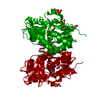








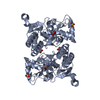


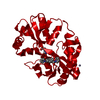
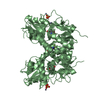
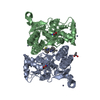


 PDBj
PDBj














